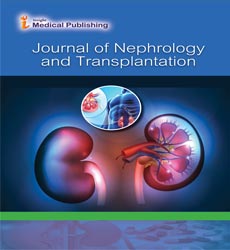Classification and Treatment of Vasculities
James Murray*
Department of Biology, Seton Hall University, Italy
- *Corresponding Author:
- James Murray
Department of Biology, Seton Hall University,
Italy;
E-mail: JamesMurray@gmail.com
Received: February 18, 2022, Manuscript No. IPNT-22-11445; Editor assigned: February 21, 2022, PreQC No. IPNT-22-11445 (PQ); Reviewed: March 07, 2022, QC No. IPNT-22-11445; Revised: March 11, 2022, Manuscript No.IPNT-22-11445 (R); Published: March 18, 2022, Invoice No. IPNT-22-11445
Citation: Murray J (2022) Classification and Treatment of Vasculities. J Nephrol Transplant Vol:6 No:1
Introduction
The nomenclature for some vasculitis has recently changed. These include granulomatosis with polyangiitis (GPA, formerly known as Wegener's granulomatosis) and eosinophilic granulomatosis with polyangiitis (formerly known as Churg- Strauss syndrome). EGPA and vasculitis (formerly Henoch- Schoenlein purpura).
They all belong to heterogeneous disease groups that can occur independently of each other such as GPA (Wegener) and Microscopic Polyangiitis (MPA) or have been established such as rheumatoid arthritis and systemic lupus erythematosus. It can occur as a complication of the disease. The term "vasculitis" means that "flame" or inflammation is directed at the vessel wall, and the result of such inflammation is damage and destruction of the vessel wall, which is histologically considered fibrinoid necrosis [1]. Therefore, the term "necrotic vasculitis" has often been used in the past. Vasculitis can be confined to a single organ or vascular bed and is relatively benign, but more common. Small muscle arteries can develop potentially lifethreatening localized or segmental lesions. The former affects part of the vessel wall, but can cause aneurysms and ruptures, and segmental lesions affect the entire circumference and occur more often, but distally [2]. It leads to stenosis or obstruction with infarction. The outcome of vasculitis depends on the location, size, and number of blood vessels affected. These pathological processes explain why severe bleeding and significant organ infarction are the most important consequences and life-threatening complications of systemic vasculitis. When only very small blood vessels (capillaries, venules) are affected, as in some small vasculitis, the most commonly affected organ is the skin, which is a sufficient number of blood vessels. Causes problems only when is involved if tissue blood flow is impaired or if there is a severe inflammatory response associated with it (especially if the kidneys are involved).
The classification of vasculitis has been a controversial area for many years, and certain classification criteria have only recently been introduced. Kussmaul and Maier provided the first explanation for "polyarteritis nodosa" when describing a patient with a systemic disease characterized by multiple nodules in the process of the muscular arteries. The most widely used classification system reflects the association between predominant vessel size and Anti-Neutrophil Cytoplasmic Antibody (ANCA). This classification system also broadly reflects therapeutic approaches applied to different groups. Small vessel groups respond well to immunosuppression by cyclophosphamide and corticosteroids, while macrovascular groups require medium to high doses of steroids, and small vessel groups sometimes require low doses of corticosteroids. I need steroids. In addition, the small mean vascular group is most likely to develop glomerulonephritis and renal failure, is associated with ANCA, and is pathologically contrasted with the small vascular group, which is often associated with immune complexes. This gave birth to the concept of Anca-Associated Vasculitis (AAV). This reflects the idea of granulomatosis with polyangiitis (Wegener) (GPA), microscopic polyangiitis [3].
In general, the cause of vasculitis is unknown. An important event is the interaction of environmental factors (unknown) with a host with a genetic predisposition. Currently, relatively little is known about important genetic factors. HLA types are important risk factors for various types of vasculitis. Infections have long been considered an important trigger, but with the exception of some specific cases, no causal link could be shown (e.g., HBV and PAN, HCV and cryoglobulinemia). Although many drugs are involved, hydralazine and propylthiouracil are clearly associated with the development of MPOANCA vasculitis.
Primary systemic vasculitis can affect the vascular system of any organ system. Depending on the caliber of the affected blood vessels and organs, vasculitis can manifest itself in different forms in different disciplines. There are no diagnostic criteria or pathological tests for systemic vasculitis. The use of classification criteria in clinical practice is disappointing and should be avoided. Chapel Hill nomenclature is similarly inadequate. Histopathology can be diagnostic, but there are varying diagnostic yields depending on the skill of the operator, the sampling method, and the organ being biopsied.
References
- Wijewickrama ES, Gunawardena N, Jayasinghe S, Herath C (2019) CKD of Unknown Etiology (CKDu) in Sri Lanka: A Multilevel Clinical Case Definition for Surveillance and Epidemiological Studies Kidney International Reports 4:781-5
[Crossref] [Google Scholor] [Pubmed]
- CKD of Unknown Etiology (CKDu) in Sri Lanka: A Multilevel Clinical Case Definition for Surveillance and Epidemiological Studies Kidney International Reports
- Anand S, Montez-Rath ME, Adasooriya D, Ratnatunga N, Kambham N, et al. (2019) Prospective Biopsy-Based Study of CKD of Unknown Etiology in Sri Lanka. Clin J Am Soc Nephrol14:224
[Crossref] [Google Scholor] [Pubmed]
Open Access Journals
- Aquaculture & Veterinary Science
- Chemistry & Chemical Sciences
- Clinical Sciences
- Engineering
- General Science
- Genetics & Molecular Biology
- Health Care & Nursing
- Immunology & Microbiology
- Materials Science
- Mathematics & Physics
- Medical Sciences
- Neurology & Psychiatry
- Oncology & Cancer Science
- Pharmaceutical Sciences
